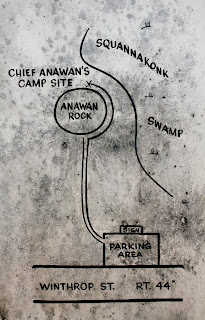THE TAUNTON RIVER
The Native American Tribe known as the Wampanoags, were indigenous to the Southeastern shore of modern-day Massachusetts. The Taunton River was the heart of the land, serving the community as a plentiful source of fish and as a mode of transportation. This same water route is believed to have been used by Captain Church to return Indian King "Metacom" Philip's body to the Plimoth Colony as a war trophy. THE 'NEW WORLD' CONVERSION A “Praying Town” for Native Americans.
ANAWAN ROCK
|
THE LIZZIE BORDEN HOUSE
“Lizzie Borden took an axe, And gave her mother forty whacks, When she saw what she had done, She gave her father forty-one.” -Anonymous |
Actually, the Bordens’ received only 29 whacks.
Mrs. Borden’s death remains a mystery.
Mr. Borden’s body was found here.
His blood was said to have pooled beneath the couch and seeped through the floorboards, into the basement.
The evidence from his murder is said to have been concealed by an area rug.
THE 'HOCKOMOCK PLAZA'
THE '44 HITCH HIKER'
The "Red-Headed Hitch Hiker" of Route 44 haunts only at night. Preferring only vehicles of young groups of three, it is cautioned to always leave a seat open if he so chooses your car as his target. Always leaving as quickly as he appeared, the “44 Hitch Hiker” often leaves behind a cigarette burn on his reserved backseat and a resonating maniacal laughter. |
“It’s really a shame what happened between the Indians and the Pilgrims way
back when. Everyone thinks of the whole ‘Thanksgiving’ thing, and figure
it was a happy time. I guess its just easier to believe that version of the story.”
-Kim, (waitress at a popular Fall River diner)
EXPLORING THE 'WITCH TREE' FIELD
In 1636 Thomas Bradbury took Mary Perkins as his bride. In 1662, at 47 years of age, Mary Perkins Bradbury was accused of causing terror in the night in the metamorphic form of a blue bull. She was later convicted of casting spells upon merchant ships, and countless other acts of sorcery. Mary Perkins Bradbury was laid to rest amidst these roots. |
THE "BUD TREE"
"PAUL DEVER"
"Most of our beliefs and superstitions are part of Indian folklore, and early settlers. And if you think about it, since the dawn of time the two things that people have fought for are religion and real estate. So if the Indians made up 'curses' or 'spirits' in this area, it was probably to protect their land."
-Evan (landscaper and martial artist)
'PROFILE ROCK'
THE 'WITCH TREE'















































